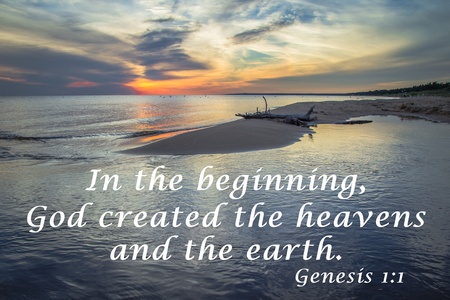
There are a variety of ways to interpret and understand the Genesis creation accounts, including whether there is one account or two separate ones. Then there is the question of where should the first account end. Certainly it doesn’t end with the last verse of chapter one, or does it? And what about that pesky debate over what to do with the days of creation? We’ll start our discussion with the question of the whether there are one or two creation accounts.
It is widely agreed upon by biblical scholars that there are two creation narratives. As C. John Collins said in Science & Faith, “I don’t think anyone disputes the idea that there are two narratives; what they dispute is where one ends and the other begins, and how the events of one relate to those of the other.” He thought the key decision was in what you do with Genesis 2:4, which reads: “These are the generations of the heavens and the earth when they were created, in the day that the Lord God made the earth and the heavens.”
Right in the middle of Genesis 2:4, the creator God is referred to as “the Lord God” for the first time. Some scholars argue this means the second part of 2:4 begins the second creation account as follows: “In the day that the Lord God made the earth and the heavens …” Additionally, the first part of 2:4 has clear similarities to 1:1, forming a literary inclusio, marking the beginning and end of the first creation account. So the first creation account begins with: “In the beginning, God created the heavens and the earth …” and ends with “… These are the generations of the heavens and the earth when they were created.”
Underlying this sense of where to spilt the two creation narratives (or accounts) is The JEPD Theory or documentary hypothesis. It holds there are four sources or traditions contributing to the Pentateuch, the Yahwist (abbreviated as J from the German word for Yahwist); the Elohist (E); the Deuteronomist (D); and the Priestly (P). The theory proposes that each source reflects a particular community and historical situation, which explains the focus of their theology. We won’t explore this further, but mention it to note the use of “the Lord God” is associated with the Yahwist (J) tradition, where Genesis 1:1-2:4a is associated with the so-called Priestly (P) tradition.
The problem with making the distinction between the two creation narratives this way is that it places the phrase “These are the generations …” at the end of a narrative, when the clear pattern in Genesis is for it to introduce a narrative or genealogy. The phrase appears at the beginning of a new section ten other times in Genesis (5:1; 6:9; 10:1; 11:10, 27; 25:12, 19; 36:1, 9; 37:2). Collins said: “It is reasonable to expect it to do the same here.” He then pointed to how in Genesis 2:4 the lines “of the heavens (a) and the earth (b) when they were created (c)” and “in the day that the Lord God made (c’) the earth (b’) and the heavens (c’)” form an elaborate mirror pattern called a chiasmus:
In this pattern the elements have the order a-b-c || c’-b’-a’, that is the second line mirrors the first in its order of elements. Scholars of the ancient Near East often feel good when they can show a chiasmus with two elements in a passage (a-b || b’-a’), though it may be chance rather than art that produced it. But when there are three elements, that’s taken as clear evidence of art—which means the author wanted you to notice it. And what was the author telling you to do once you noticed it? He wanted you to read it as a whole thought, without breaking it apart.”
So we see that the chiastic structure resists the temptation to divide verse 2:4, but is there more? In his commentary on Genesis 1-4, Collins suggested Genesis 2:4 acts as a hinge verse between the two creation narratives. The word order of Genesis 2:4a (the heavens and the earth) and the verb “created” point back to Genesis 1:1. The new divine name in 2:4b, “the Lord God,” points forward to Genesis 2:5-3:24. It also combines “God” as the title of the deity in his role as Creator with the name “Lord,” which in Hebrew is his personal, covenantal name (Ex. 3:13-15). So the covenant God of Israel (Yahweh or Lord) is the Creator of heaven and earth (God or Elohim). “It follows easily, then, that the author or editor wanted his audience to read these two accounts as complementary.”
But there is a potentially serious problem in the verses following 2:4 if we try to harmonize the two creation narratives. Despite this, Collins doesn’t think we can read the first creation narrative as being independent of the rest of Genesis; and from there the rest of the Bible. It’s part of a context. In order to illustrate the problem, look first at Genesis 2:5-7:
5 When no bush of the field was yet in the land and no small plant of the field had yet sprung up—for the Lord God had not caused it to rain on the land, and there was no man to work the ground, 6 and a mist was going up from the land and was watering the whole face of the ground— 7 then the Lord God formed the man of dust from the ground and breathed into his nostrils the breath of life, and the man became a living creature.
In Genesis 1:11-12, God made the plants on the third day. But here, it seems the text is saying plants didn’t exist until the sixth day, when God formed man from the dust of the ground. In order to make sense of this apparent contradiction, Collins pointed to the Hebrew word translated as land, ’eres, in the ESV translation. The word can refer to “the earth” in a cosmological sense, as it does in Genesis 1:1-2; or to “the land” in the sense of a specific territory (1:10), such as Palestine. Here’s why that is important.
Palestine doesn’t get rain in the summer, so plants don’t grow until the autumn rains bring about a burst of plant growth. “So verses 5-7 would make good sense if we supposed that they describe a time of year, when it has been a dry summer, so the plants aren’t growing” because God hadn’t caused the rain and there was not anyone around to work the ground yet. “The plants are missing, it says, because there’s no rain, and no man to cultivate and irrigate.” Collins said the only way he can make sense of this explanation is if he imagined the cycle of rain, plant growth, and dry season had been going on for a number of years before this point. Significantly, “the text says nothing about God not yet having made the plants.”
In some particular land, in some particular year, at the time of year before the rainy season began, but when the mist (or rain cloud) was rising (which may suggest the beginning of the rainy season)—that’s when God formed the first human, planted the Garden of Eden, and transplanted man there. (By the way, that also explains … “a mist was going up”).
This interpretation by Collins shows the events of 2:5-25 happened on the sixth day of chapter 1. It also shows the second creation narrative is an expansion of the chapter 1 account of the sixth day. And it means we shouldn’t confuse 2:5-6 with the third day of chapter 1. Lastly, “if we are to follow the lead the way Moses has narrated these details—especially the bit about the cycle of seasons going on for some time—then we have to say the length of the creation week could not have been an ordinary week: it must have been longer.”
In Part 2, we look at what C. John Collins suggests for how to interpret the days of creation in Genesis 1 if they weren’t ordinary 24-hour days. For more articles on creation in the Bible, see the link “Genesis & Creation.”




